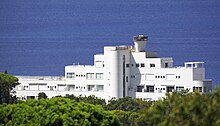Latitude 43
Coordinates: 43 ° 15 ′ 56 " N , 6 ° 37 ′ 55" E
The Latitude 43 is a structure in Saint-Tropez . With the hotel, the French architect and town planner Georges-Henri Pingusson created his most important masterpiece in the Mouvement Moderne style, of which he was one of the enthusiastic representatives. The architect trained from 1919 to 1925 in the workshops of Gustave Umbdenstock and Paul Tournon at the École des Beaux-Arts in Paris, was a member of the Union des Artistes Modernes and its president from 1949 to 1957. With the Latitude 43, he influenced the architecture of the 1930s on the Côte d'Azur .
Building history
The idea of building a hotel in Saint-Tropez was developed between the patron Georges Bernet and the young architect on the occasion of a sea voyage. The extensive construction project included around a hundred rooms, a restaurant, spacious sports facilities, two swimming pools and a casino in the middle of a pine grove. Construction began in January 1932. More than two hundred workers were employed to open the hotel in July of the same year, just in time for the summer season. However, the original preliminary design was not fully completed and sold due to the bankruptcy of the building contractor and later the hotel company. From 1937 onwards, the complex was rebuilt by Pingusson and the hotel reopened in the spring of 1939. In 1948 the hotel was converted into holiday apartments and sold as an apartment.
idea
The Latitude 43 (43rd degree of latitude) was created at the same time as the legendary ocean liner Normandie . The age is determined by the enthusiasm for technology and speed. Motifs such as ocean liner, automobile, railroad and airplane influence the architectural ideas. Well-known architects such as Le Corbusier , Pierre Chareau , Robert Mallet-Stevens and Eileen Gray developed designs in this experimental field that take up the motifs of technology and thus break away from existing conventions. On the poster for the hotel that appeared in 1932, the ship is shown as the idea for the Latitude 43.
Floor plan and design
The hotel complex looks like a gigantic ocean liner stranded in a pine grove. The one-hip floor plan is determined by the view over the Gulf of Saint-Tropez in the north and the land side in the south. The corridors resemble the ship passages and the detail of the spiral main staircase with round windows transports the visitor into the interior of a passenger steamer. All hotel rooms are accessible in two directions. The idea of lowering the ceiling heights of the access galleries in the north by half a storey made it possible to arrange windows between the storeys that allow guests a panoramic view of the sea. The center of the system is the vertical stair tower that interrupts the horizontal storeys like the command center of a steamship. During the renovations in 1937, delicate escape stairs were added at the western end of the corridors. The lines of the narrow floor plan are reminiscent of the hull and the rounded gables of the bow of a steamer.
composition
The building is shaped by the avant-garde ideas that were strictly committed to modernity from the 1920s and the repertoire of forms developed from them. The building is a historical monument.
literature
- Simon Texier: Georges-Henri Pingusson Architecte (1894-1978), Éditions Verdier, ISBN 2-86432-480-6
- Alfred Werner Maurer : Georges-Henri Pingusson - an architect of the Union des Artistes Modernes (UAM), Philologus Verlag, Basel (ch) 2010
- Alfred Werner Maurer: Architectural icons Provence, Côte d'Azur + Riviera - Latitude 43 in Saint-Tropez, Philologus Verlag, Basel (ch) 2008.
- Alfred Werner Maurer: Architect George-Henri Pingusson and the motif of the ocean liner - genesis and idea for the Latitude 43 in Saint-Tropez, Philologus Verlag, Basel (ch) 2009
- Helmut Giersiefen: Latitude 43 - Saint-Tropez (2018)


